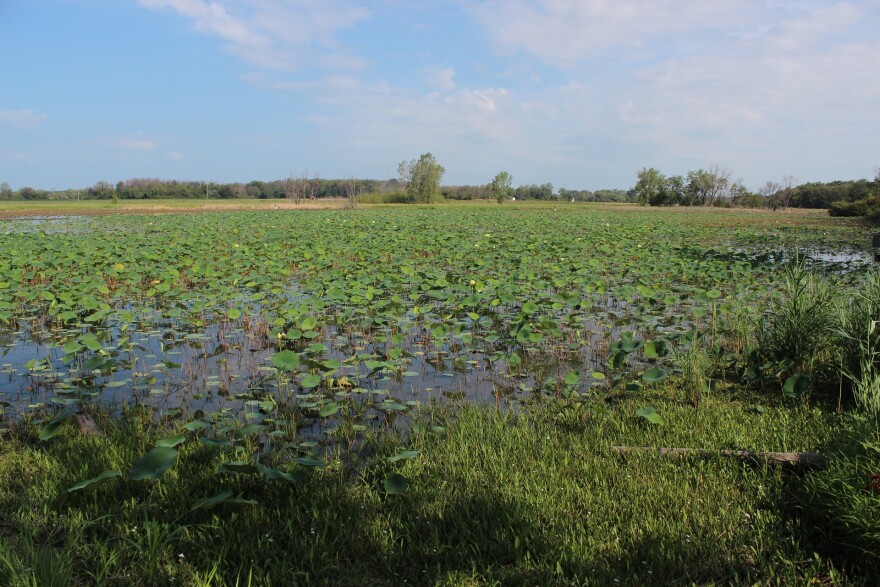It’s been more than a decade since toxic algal blooms caused Lake Erie’s western shore to turn bright green and the residents of Toledo to lose water for four days.
Since then, many scientists and environmentalists have been working to reduce phosphorus runoff, flowing from fertilized fields into the Great Lake. Toledo residents even once declared personhood for Lake Erie in an effort to protect it – before courts struck the measure down.
In his new book “The Great Black Swamp: Toxic Algae, Toxic Relationships and the Most Interesting Place Nobody’s Ever Heard Of,” Patrick Wensink posits that the answer to reversing the blooms may lie in northwest Ohio’s swampy past.
He sat down for an interview with The Ohio Newsroom to discuss his new environmental memoir.
This interview has been lightly edited for brevity and clarity.
On the region’s reputation as the “Great Black Swamp” before settlement
“Ohio's Great Black Swamp is one of the least reported places in America. It was settled later than even parts of the Everglades. It was one million acres [with] six feet deep of mud and it was so densely packed with trees that there was no light, which is where the name the Great Black Swamp comes from.”
“It was full of bears and snakes and wolves and a malaria rate that was so high that at one point people called it the deadliest place in America. And so for decades and decades, people tried to carve a path through it. Folks just went missing and it was just avoided at all costs.”

On how the landscape changed
“It took about 50 or 60 years, starting in the early 1800s. The swamp, at the time, was about the size of Connecticut, actually. It was really huge. And it was standing in between Chicago and New York almost directly. So folks were trying constantly to find a way to get through it so they could shorten the travel time for commerce and for immigration. … They tried building trains through it, and the trestles just got sucked into the ground. It was just as if the environment itself was fighting back against settlement.”
“Eventually in the late 1800s, a man called James B. Hill invented a machine called the Buckeye Traction Ditcher, which accounts for so much of the landscape that you see in Ohio Northwest Ohio. The machine essentially figured out a way to put drainage tile efficiently throughout northwest Ohio. There are these huge drainage ditches just running along just about every road and that's a direct result of Hill's invention, which, in less than ten years, converted the swamp from this dense, dark, heavy metal looking place of danger to a pastoral farmland that we know today.”
“Coincidentally then, because of all that, those ditches are what was directly draining all the phosphorus that led to the 2014 algal blooms. So it's a funny set of dominoes that take place over a couple of hundred years.”

On efforts to restore wetland to the area
“After the 2014 algal blooms, people were really up in arms and worried about this … so they tried legislation, they tried chemical stuff. They even cut back on how much fertilizer was used, which is the main cause of all that phosphorus runoff, and nothing was really doing the trick. And so it almost seemed like there was just no answer at this point because farmers can't just stop farming.”
“The only real answer that I've seen getting any results are these folks who are rewilding the landscape up there. Folks like the Black Swamp Conservancy, H2Ohio, these amazing organizations that go around and purchase farmland and other bits of land that often flood still and turn them back into swamp land, replanting natural grasses, reshaping the landscape so it's a little bit more like it was during the the dangerous old days.”
“What that does is it traps a lot of that phosphorus runoff and naturally filters the phosphorus out. One expert told me it acts like a kidney for the landscape. Unfortunately, it's a big project and it's gonna take a long, long time to get enough land back there. But these folks are doing it and they're just starting to see some really positive results in their efforts.”
On the ‘Midwestern ambivalence’ to the issue
“Along the path of writing this book and talking to folks and thinking about my own relationship to the land and to northwest Ohio, I realized that I have a sort of ambivalence to it. I think, ‘Well, that's just the way it is.’ And I feel like I've heard that my whole life from other folks that I knew around northwest Ohio. We have a really strong work ethic, a kind of ‘put your nose down and just keep working’ kind of mentality, which is really great and really wonderful. But in situations like this, I wonder if maybe a little self-reflection wouldn't be beneficial because then we can see the changes we could make to help.”



